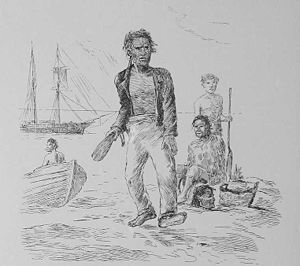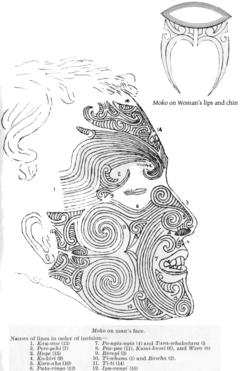
Mokomokai
Encyclopedia

New Zealand
New Zealand is an island country in the south-western Pacific Ocean comprising two main landmasses and numerous smaller islands. The country is situated some east of Australia across the Tasman Sea, and roughly south of the Pacific island nations of New Caledonia, Fiji, and Tonga...
, where the faces have been decorated by tā moko
Ta moko
Tā moko is the permanent body and face marking by Māori, the indigenous people of New Zealand. Traditionally it is distinct from tattoo and tatau in that the skin was carved by rather than punctured...
tattoo
Tattoo
A tattoo is made by inserting indelible ink into the dermis layer of the skin to change the pigment. Tattoos on humans are a type of body modification, and tattoos on other animals are most commonly used for identification purposes...
ing. They became valuable trade items during the Musket Wars
Musket Wars
The Musket Wars were a series of five hundred or more battles mainly fought between various hapū , sometimes alliances of pan-hapū groups and less often larger iwi of Māori between 1807 and 1842, in New Zealand.Northern tribes such as the rivals Ngāpuhi and Ngāti Whātua were the first to obtain...
of the early 19th century.
Moko
Moko facial tattoos were traditional in Māori culture until about the mid 19th century when their use began to disappear, although there has been something of a revival from the late 20th century. In pre-European Māori culture they denoted high social status. It is was generally only men that had full facial moko, though high-ranked women often had moko on their lips and chins.Moko marked rites of passage for people of chiefly rank, as well as significant events in their lives. Each moko was unique and contained information about the person’s rank, tribe, lineage, occupation and exploits. Moko were expensive to obtain and elaborate moko were usually limited to chiefs and high-ranked warriors. Moreover, the art of moko, the people who created and incised the designs, as well as the moko themselves, were surrounded by strict tapu and protocol.

Mokomokai
When someone with moko died, often the headHead
In anatomy, the head of an animal is the rostral part that usually comprises the brain, eyes, ears, nose and mouth . Some very simple animals may not have a head, but many bilaterally symmetric forms do....
would be preserved. The brain and eyes were removed, with all orifices sealed with flax fibre and gum. The head was then boiled or steamed in an oven before being smoked over an open fire and dried in the sun for several days. It was then treated with shark oil. Such preserved heads, mokomokai, would be kept by their families in ornately-carved boxes and brought out only for sacred ceremonies.
The heads of enemy chiefs killed in battle were also preserved; these mokomokai, being considered trophies of war
War trophy
In ancient Greece and Rome, military victories were commemorated with a display of captured arms and standards. A trophy was originally a war memorial assembled from such items on a battlefield. The Roman triumph also displayed these items as well as cultural objects, which later came to be...
, would be displayed on the marae and mocked. However, they were important in diplomatic negotiations between warring tribes, with the return and exchange of mokomokai being an essential precondition for peace.
Musket Wars
In the early 19th century, with the arrival of Europeans in New Zealand, tribes in contact with European sailors, traders and settlers had access to firearmFirearm
A firearm is a weapon that launches one, or many, projectile at high velocity through confined burning of a propellant. This subsonic burning process is technically known as deflagration, as opposed to supersonic combustion known as a detonation. In older firearms, the propellant was typically...
s, giving them a military advantage over their neighbours. This gave rise to the Musket Wars, when other tribes became desperate to acquire firearms too, if only to defend themselves. It was during this period of social destabilisation that mokomokai became commercial trade items that could be sold as curios, artworks and as museum specimens which fetched high prices in Europe and America, and which could be bartered for firearms and ammunition
Ammunition
Ammunition is a generic term derived from the French language la munition which embraced all material used for war , but which in time came to refer specifically to gunpowder and artillery. The collective term for all types of ammunition is munitions...
.
The demand for firearms was such that tribes carried out raids on their neighbours to acquire more heads to trade for them. They also tattooed slaves and prisoners (though with meaningless motifs rather than genuine moko) in order to provide heads to order. The peak years of the trade in mokomokai were from 1820 to 1831. In 1831 the Governor of New South Wales issued a proclamation banning further trade in heads out of New Zealand, and during the 1830s the demand for firearms diminished because of market saturation
Market saturation
In economics, "market saturation" is a term used to describe a situation in which a product has become diffused within a market; the actual level of saturation can depend on consumer purchasing power; as well as competition, prices, and technology....
. By 1840 when the Treaty of Waitangi
Treaty of Waitangi
The Treaty of Waitangi is a treaty first signed on 6 February 1840 by representatives of the British Crown and various Māori chiefs from the North Island of New Zealand....
was signed, and New Zealand became a British colony
British Empire
The British Empire comprised the dominions, colonies, protectorates, mandates and other territories ruled or administered by the United Kingdom. It originated with the overseas colonies and trading posts established by England in the late 16th and early 17th centuries. At its height, it was the...
, the export trade in mokomokai had virtually ended, along with a decline in the use of moko in Māori society, although occasional small-scale trade continued for several years.

The Robley collection
Major-GeneralMajor-General (United Kingdom)
Major general is a senior rank in the British Army. Since 1996 the highest position within the Royal Marines is the Commandant General Royal Marines who holds the rank of major general...
Horatio Gordon Robley was a British army officer and artist who served in New Zealand during the New Zealand land wars
New Zealand land wars
The New Zealand Wars, sometimes called the Land Wars and also once called the Māori Wars, were a series of armed conflicts that took place in New Zealand between 1845 and 1872...
in the 1860s. He was interested in ethnology
Ethnology
Ethnology is the branch of anthropology that compares and analyzes the origins, distribution, technology, religion, language, and social structure of the ethnic, racial, and/or national divisions of humanity.-Scientific discipline:Compared to ethnography, the study of single groups through direct...
and fascinated by the art of tattooing as well as being a talented illustrator. He wrote the classic text on the subject of moko, Moko; or Maori Tattooing, which was published in 1896. After he returned to England he built up a notable collection of 35-40 mokomokai which he later offered to sell to the New Zealand Government. When the offer was declined, most of the collection was sold to the American Museum of Natural History
American Museum of Natural History
The American Museum of Natural History , located on the Upper West Side of Manhattan in New York City, United States, is one of the largest and most celebrated museums in the world...
.
Repatriation
More recently there has been a campaign to repatriate to New Zealand the hundreds of mokomokai held in museums and private collections around the world, either to be returned to their relatives or to the Museum of New ZealandMuseum of New Zealand Te Papa Tongarewa
The Museum of New Zealand Te Papa Tongarewa is the national museum and art gallery of New Zealand, located in Wellington. It is branded and commonly known as Te Papa and Our Place; "Te Papa Tongarewa" is broadly translatable as "the place of treasures of this land".The museum's principles...
for storage, though not display. It has had some success, though many mokomokai remain overseas and the campaign is ongoing.
Sources
- Janes, Robert R.; & Conaty, Gerald T. (2005). Looking Reality In The Eye: Museums and Social Responsibility. University of Calgary Press. ISBN 978-1-55238-143-4
- Palmer, Christian; & Tano, Mervyn L. (2004). Mokomokai: Commercialization and Desacralization. International Institute for Indigenous Resource Management: Denver, Colorado.http://www.iiirm.org/publications/Articles%20Reports%20Papers/Genetics%20and%20Biotechnology/mokomokai.pdf Accessed 25 November 2008.
Further reading
- Robley, H.G.Horatio Gordon RobleyHoratio Gordon Robley was a soldier, artist and collector of Mokomokai and antiquities.Robley was born at Funchal, Madeira on 28 June 1840, the son of Captain John Horatio Robley and Augusta June Penfold. Robley followed in his father's footsteps and became a professional soldier...
(1896). Moko; Maori Tattooing. Chapman & Hall: London. Full text at the NZETC.

